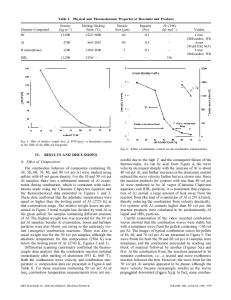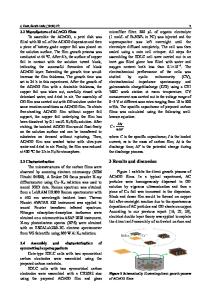Microwave-assisted synthesis of MoS 2 /graphene composites for supercapacitors
- PDF / 1,790,946 Bytes
- 9 Pages / 595.276 x 790.866 pts Page_size
- 31 Downloads / 343 Views
Microwave-assisted synthesis of MoS2/graphene composites for supercapacitors Min Fu1,* 1
, Zitong Zhu1, Wei Chen1,*, Hao Yu1, and Qingyun Liu1,*
College of Chemistry and Bioengineering, Shandong University of Science and Technology, Qingdao 266590, China
Received: 1 June 2020
ABSTRACT
Accepted: 30 August 2020
Transition metal sulfides have been used in energy storage field recently, while single component can no longer meet increasing requirements of energy storage devices. Combining metal sulfides with carbon is proved to be feasible. Herein, microwave-assisted synthesis of MoS2/graphene composites is proposed. Uniform and small MoS2 nanoparticles can be rapidly grown on graphene by this method, which endows as-prepared composites with superior capacitive properties. The resulting MoS2/graphene composites exhibit a specific capacitance of 401.1 F g-1 at 1 A g-1 and 95.0% capacitance over 10000 cycles at 5 A g-1. Furthermore, they exhibit a high energy density of 26.4 Wh kg-1 at a power density of 1015.4 W kg-1, disclosing outstanding capacitive performances.
Ó
Springer Science+Business
Media, LLC, part of Springer Nature 2020
Introduction Providing abundant power storage for an increasing number of electronic products is a growing challenge in the field of energy storage [1]. Supercapacitors (SCs), also called electrochemical capacitors, have attracted massive attention and become a promising candidate for energy storage because of their high power density and fabulous constancy [2, 3]. However, the energy density (4–5 Wh kg-1) of commercial SCs is too low to meet increasing standards of energy storage devices [4]. The inherent characteristics of electrode materials are crucial for electrochemical performances of SCs. Therefore,
considerable efforts are focused on the design of electrode materials to increase the energy density without losing their intrinsic merits [3]. Up to now, carbon materials have been commonly used in SCs [5]. Among them, graphene with twodimensional (2D) structure is becoming the focus of electrode materials in SCs owing to its fantastic electrical conductivity, high chemical stability, mechanical property and specific surface area [6, 7]. However, virginal graphene as electrodes cannot meet increasing requirements including high energy density and power density for SCs [8]. A number of studies have shown that electrochemical performances of SCs can be enhanced by combing electrochemical pseudocapacitive materials
Handling Editor: Mark Bissett.
Address correspondence to E-mail: [email protected]; [email protected]; [email protected]
https://doi.org/10.1007/s10853-020-05201-5
J Mater Sci
with graphene [6, 9–11]. Currently used pseudocapacitive materials are mainly transition metal oxides, hydroxides or sulfides because of their rich Faraday reactivity [12–18]. Among them, transition metal sulfides (TMSs) holding conductivity and electrochemical activity together are considered to be one of the most efficient electrode materials, which have the potential to approach or eve
Data Loading...











